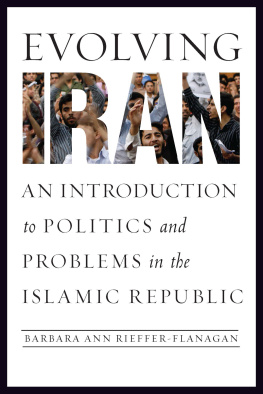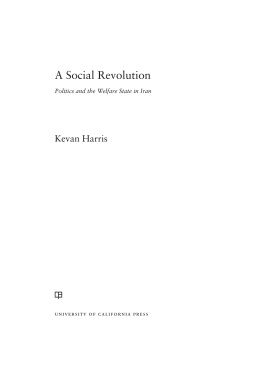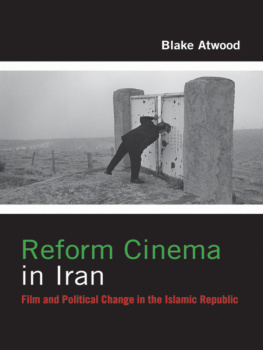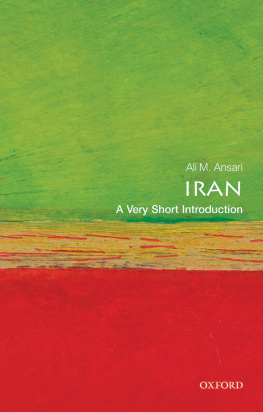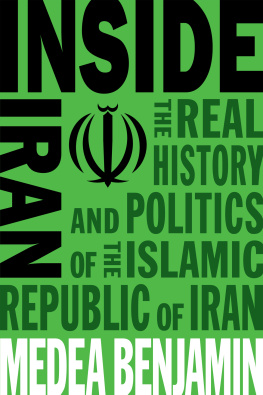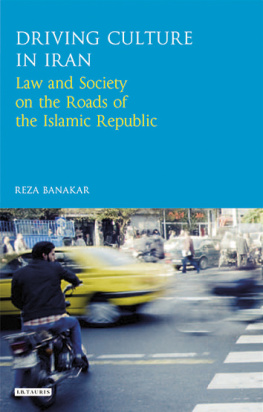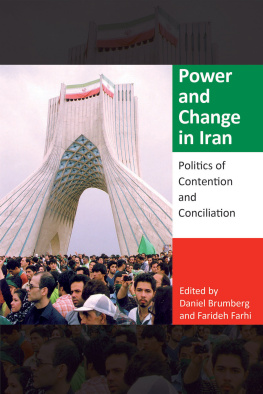2013 Georgetown University Press. All rights reserved. No part of this book may be reproduced or utilized in any form or by any means, electronic or mechanical, including photocopying and recording, or by any information storage and retrieval system, without permission in writing from the publisher.
Library of Congress Cataloging-in-Publication Data
Rieffer-Flanagan, Barbara Ann J.
Evolving Iran : an introduction to politics and problems in the Islamic republic / Barbara Ann Rieffer-Flanagan.
pages cm
Includes bibliographical references and index.
ISBN 978-1-58901-978-2 (pbk. : alk. paper)
1. IranPolitics and government19791997. 2. IranPolitics and government19973. IranEconomic policy1979- 4. Human rightsIranHistory. I. Title.
DS318.8.R54 2013
955.05'4dc23
2012037548
This book is printed on acid-free paper meeting the requirements of the American National Standard for Permanence in Paper for Printed Library Materials.
15 14 13 9 8 7 6 5 4 3 2 First printing
PREFACE
This book brings together scholarship from various highly focused academic works and seeks to distill a general and systematic overview of Irans political and economic system since the 1979 Islamic Revolution. The opening chapters provide the foundation and history to help the reader understand those events that provided the motivation for the Revolution. Next I cover a broad array of subjects, including foreign policy, human rights, womens struggle for equality, the development and evolution of elections and the institutions of the political system, and the economy. My emphasis in this book is to show how and why political decisions are made in the Islamic Republic of Iran.
I have spent a decade studying the Islamic Republic of Iran and grappling with its politics. A number of individuals helped me as I embarked on the long process that led to this book. This book was supported by a grant from the Office of the Dean of the College of the Sciences at Central Washington University. Beyond providing funding for this research project, Kirk Johnson has been a very supportive dean. I will always appreciate his willingness to give his time and advice to a young faculty member. Jean Cahan, Dave Forsythe, Pam McMullin-Messier, and Mahmood Monshipouri were kind enough to read and comment on the earlier materials that went into the creation of this book. I am especially grateful to Dave Forsythe for his encouragement throughout graduate school and beyond. Although his research never focused on the Islamic Republic of Iran, this did not prevent him from reading and offering his advice on numerous drafts on the Revolution, Iranian foreign policy, and human rights. I am grateful that Dave has been a tough but supportive mentor to me over the years. Don Jacobs was an understanding and helpful editor at Georgetown University Press. Finally, I thank my family for putting up with my never-ending comments about Iran. I am sure that they grew tired of hearing me talk about Irans theocracy and the political leaders that make Iran such an interesting country to study. I will always be grateful for their understanding.
GLOSSARY
Ashura. Shia religious holiday honoring the day of Imam Hosains martyrdom.
ayatollah. Typically refers to a well-respected and high-ranking religious leader in the Shia tradition. It literally means sign of God.
basij. Mobilization, a volunteer paramilitary force.
bazaar. A marketplace or area of town where goods are sold.
bonyads. Charitable foundations.
brain drain. The loss of educated people due to emigration.
burka. A loose-fitting garment that covers a womans body from head to toe, including her face.
chador. A loose-fitting garment that covers a womans body from head to toe.
exegesis. A critical interpretation of a religious text.
faqih. Jurist or religious scholar.
fatwa. Religious decree; pronouncement.
GDP. Gross domestic productthe production of goods and services within a country.
gharb zadegi. Sometimes translated as Westoxification, it typically refers to a desire for Western culture and ideas. It is used as a criticism of the loss of Persian culture.
hadith. Stories attributed to the Prophet Muhammad.
haqq. Rights.
hijab. A piece of clothing, typically a veil or scarf, that covers the head and neck.
iefan. Islamic mysticism
ijtihad. The interpretation of religious texts through independent reasoning.
imam. Religious leader.
komitehs. Neighborhood committees.
Majles. Assembly, parliament.
mostazafin. The deprived, downtrodden, or the disinherited.
mujtahids. Religious leaders.
Qajar Dynasty. The ruling family in Iran (Persia) from 1794 to 1925.
Quran. Holy book for Muslims.
SAVAK. Sazman-i Ittiliat va Amniyat-I Kishvar, the National Intelligence and Security Organization; this security service was created in 1957 and was used to crush any political opposition to the monarchy.
sayyid. Someone who claims descent from the Prophet Muhammad.
shah. A word for king.
shahid. Martyr.
Sharia. Islamic law; the rules and regulations that guide the life of a Muslim.
taghut. Idolatry, false gold.
talebehs. Religious students.
theocracy. A political system that is governed according to religious principles.
ulema. Religious scholars.
vaqf. Religious endowment.
velayat-e faqih. Guardianship of the jurist.
CHAPTER 1
Introduction
The Incomplete Revolution
The June 2009 presidential elections were a significant event in Iranian politics. These elections offered Irans political system the opportunity to take another step along a democratic path. The presidential election pitted President Mahmoud Ahmadinejad against a rather uncharismatic former prime minister, Mir-Hossein Mousavi. However, instead of democratic images of people voting, Iranians and observers around the world were left with the image of a young woman in blue jeans.
On June 20, 2009, Neda Agha Soltan walked to a demonstration in Tehran. Many protesters, frustrated with the election results and their lack of political influence, took to the streets after Ahmadinejad was declared the winner. As Neda walked along Kargar Avenue, she was shot by Abbas Kargar Javid, a man associated with the Basijisa progovernment militia. The video footage captured international attention for the graphic depiction of her deathblood streamed from her nose and chest as she lay dying on an ordinary street in Tehran. The image also captured the brutality of the regime and the numerous human rights violations that the theocratic regime has committed.

